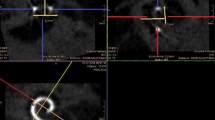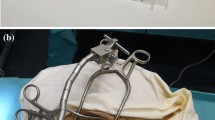Abstract
Purpose
Validation of a novel minimally invasive, image-guided approach to implant electrodes from three FDA-approved manufacturers—Medel, Cochlear, and Advanced Bionics—in the cochlea via a linear tunnel from the lateral cranium through the facial recess to the cochlea.
Methods
Custom microstereotactic frames that mount on bone-implanted fiducial markers and constrain the drill along the desired path were utilized on seven cadaver specimens. A linear tunnel was drilled from the lateral skull to the cochlea followed by a marginal, round window cochleostomy and insertion of the electrode array into the cochlea through the drilled tunnel. Post-insertion CT scan and histological analysis were used to analyze the results.
Results
All specimens (\(N=7\)) were successfully implanted without visible injury to the facial nerve. The Medel electrodes (\(N=3\)) had minimal intracochlear trauma with 8, 8, and 10 (out of 12) electrodes intracochlear. The Cochlear lateral wall electrodes (straight research arrays) (\(N=2\)) had minimal trauma with 20 and 21 of 22 electrodes intracochlear. The Advanced Bionics electrodes (\(N=2\)) were inserted using their insertion tool; one had minimal insertion trauma and 14 of 16 electrodes intracochlear, while the other had violation of the basilar membrane just deep to the cochleostomy following which it remained in scala vestibuli with 13 of 16 electrodes intracochlear.
Conclusions
Minimally invasive, image-guided cochlear implantation is possible using electrodes from the three FDA-approved manufacturers. Lateral wall electrodes were associated with less intracochlear trauma suggesting that they may be better suited for this surgical technique.






Similar content being viewed by others
References
National Institute on Deafness and Other Communication Disorders. http://www.nidcd.nih.gov/health/hearing/pages/coch.aspx
Kiratzidis T, Arnold W, Iliades T (2002) Veria operation updated. I. The trans-canal wall cochlear implantation. ORL 64:406–412
Kronenberg J, Migirov L, Baumgartner W (2002) The suprameatal approach in cochlear implant surgery: our experience with 80 patients. ORL 64:403–405
Kronenberg J, Baumgartner W, Migirov L (2004) The suprameatal approach: an alternative surgical approach to cochlear implantation. Otol Neurotol 25:41–45
Mann W, Gosepath J (2006) Technical note: minimal access surgery for cochlear implantation with MedEl devices. ORL 68:270–272
O’Donoghue G, Nikolopoulos T (2002) Minimal access surgery for pediatric cochlear implantation. Otol Neurotol 23:891–894
Stratigouleas ED, Perry BP, King SM et al (2006) Complication rate of minimally invasive cochlear implantation. Otol Head Neck Surg 135:383–386
Warren FM, Balachandran R, Fitzpatrick JM et al (2007) Percutaneous cochlear access using bone-mounted, customized drill guides: demonstration of concept in vitro. Otol Neurotol 28:325–329
Labadie RF, Mitchell JE, Balachandran R et al (2009) Customized, rapid-production microstereotactic table for surgical targeting: description of concept and in vitro validation. Int J CARS 4:273–280
Balachandran R, Mitchell JE, Blachon G et al (2010) Percutaneous cochlear implant drilling via customized frames: an in vitro study. Otol-Head Neck Surg 142:421–426
Labadie RF, Noble JH, Dawant BM et al (2008) Clinical validation of percutaneous cochlear implant surgery: initial report. Laryngoscope 118:1031–1039
Labadie RF, Balachandran R, Mitchell J et al (2009) Clinical validation study of percutaneous cochlear access using patient customized microstereotactic frames. Otol Neurotol 31:94–99
Labadie RF, Chodhury P, Cetinkaya E et al (2005) Minimally invasive, image-guided, facial recess approach to the middle ear: demonstration of the concept of percutaneous cochlear access in vitro. Otol Neurotol 26:557–562
Balachandran R, Schurzig D, Fitzpatrick JM et al (2012) Evaluation of portable CT scanners for otologic image-guided surgery. IJCARS 7(2):315–321
Noble JH, Warren FM, Labadie RF et al (2008) Automatic segmentation of the facial nerve and chorda tympani in CT images using spatially dependent feature values. Med Phys 35:5375–5384
Noble JH, Dawant BM, Warren FM et al (2009) Automatic identification and 3D rendering of temporal bone anatomy. Otol Neurotol 30:436–442
Noble JH, Majdani O, Labadie RF, Dawant B, Fitzpatrick JM (2010) Automatic determination of optimal linear drilling trajectories for cochlear access accounting for drill-positioning error. Int J Med Robot 6(3):281–290
Liu X, Cevikalp H, Fitzpatrick JM (2003) Marker orientation in fiducial registration. In: Proceedings of SPIE medical imaging, San Diego, CA, vol 5032. pp 1176–1185, Feb 2003
Maes F, Collignon A, Vandermeulen D et al (1997) Multimodality image registration by maximization of mutual information. IEEE Trans Med Imaging 16:187–198
Kratchman LB, Schurzig D, McRackan TR et al (2012) A manually-operated, advance off stylet insertion tool for minimally-invasive cochlear implantation surgery. IEEE Trans Biomed Eng 59(10):2792–2800
Schuman T, Noble J, Wright G et al (2010) Anatomic verification of a novel, non-rigid registration method for precise intrascalar localization of cochlear implant electrodes in adult human temporal bones using portable computerized tomography. Laryngoscope 120:2277–2283
Wright CG, Roland PS (2005) Temporal bone microdissection for anatomic study of cochlear implant electrodes. Cochlear Implants Int 6:159–168
Schurzig D, Webster RJ, Dietrich MS, Labadie RF (2010) Force of cochlear implant electrode insertion performed by a robotic insertion tool: comparison of traditional versus advance-off stylet techniques. Otol Neurotol 31(8):1207–1210
Nadol JB Jr, Ketten DR, Burgess BJ (1994) Otopathology in a case of multichannel cochlear implantation. Laryngoscope 104:299–303
Nadol JB Jr, Shiao JY, Burgess BJ et al (2001) Histopathology of cochlear implants in humans. Ann Otol Rhinol Laryngol 110(9):883–891
Finley CC, Holden TA, Holden LK et al (2008) Role of electrode placement as a contributor to variability in cochlear implant outcomes. Otol Neurotol 29:920–928
Wanna GB, Noble JH, McRackan TR et al (2011) Assessment of electrode placement and audiological outcomes in bilateral cochlear implantation. Otol Neurotol 32:428–432
Roland JT (2005) A model for cochlear implant electrode insertion and force evaluation: results with a new electrode design and insertion technique. Laryngoscope 115:1325–1339
Shannon RV, Zeng F-G, Wygonski J (1996) Speech recognition with altered spectral distribution of envelope cues. J Acoust Soc Am 100:2468–2476
Zeitler DM, Lalwani AK, Roland JT Jr, Habib MG, Gudis D, Waltzman SB (2009) The effects of cochlear implant electrode deactivation on speech perception and in predicting device failure. Otol Neurotol 30(1):7–13
Holden LK, Reeder RM, Firszt JB, Finley CC (2011) Optimizing the perception of soft speech and speech in noise with the Advanced Bionics cochlear implant systm. In J Audiol 50(4):255–269
Noble JH, Labadie RF, Gifford RH, Dawant BM (2013) Image-guidance enables new methods for customizing cochlear implant stimulation strategies. IEEE Trans Neural Syst Rehabilit Eng (in press)
Acknowledgments
The project described was supported by Award Number R01DC008408 and R01DC010184 from the National Institute on Deafness and Other Communication Disorders. The content is solely the responsibility of the authors and does not necessarily represent the official views of the National Institute on Deafness and Other Communication Disorders or the National Institutes of Health.
Conflict of Interest
Robert F. Labadie, M.D., Ph.D. is a consultant for Cochlear Corporation, Medel Corporation, and Ototronix. Drs. Dawant, Fitzpatrick, Noble, and Labadie hold intellectual property rights on aspects of the technology described herein some of which may lead to commercialization with the potential for financial benefit to them.
Author information
Authors and Affiliations
Corresponding author
Additional information
T. R. McRackan and R. Balachandran: both authors contributed equally to this work and are co-first authors.
Rights and permissions
About this article
Cite this article
McRackan, T.R., Balachandran, R., Blachon, G.S. et al. Validation of minimally invasive, image-guided cochlear implantation using Advanced Bionics, Cochlear, and Medel electrodes in a cadaver model. Int J CARS 8, 989–995 (2013). https://doi.org/10.1007/s11548-013-0842-6
Received:
Accepted:
Published:
Issue Date:
DOI: https://doi.org/10.1007/s11548-013-0842-6




